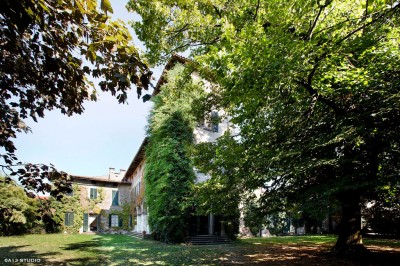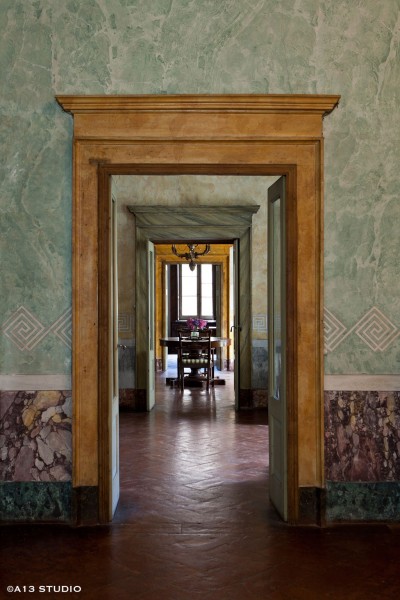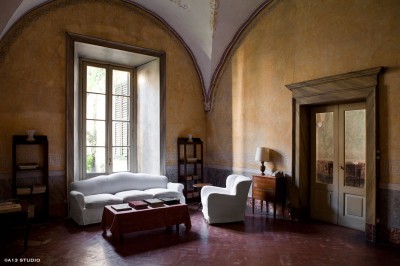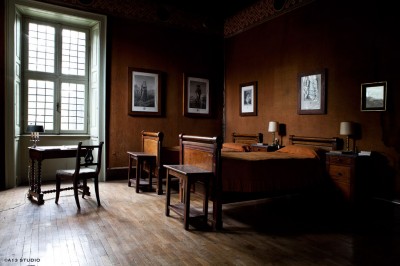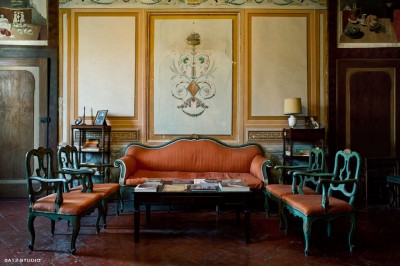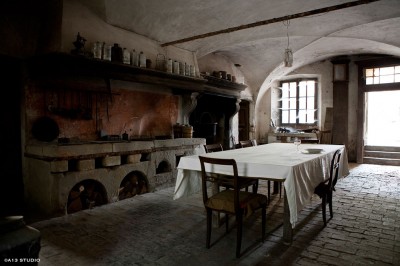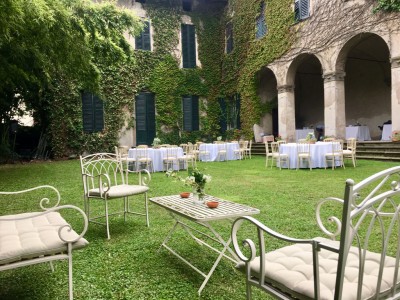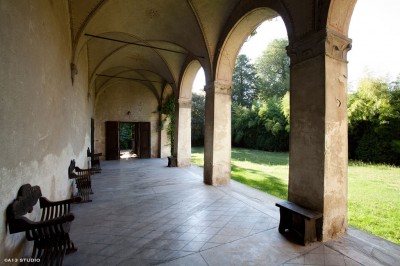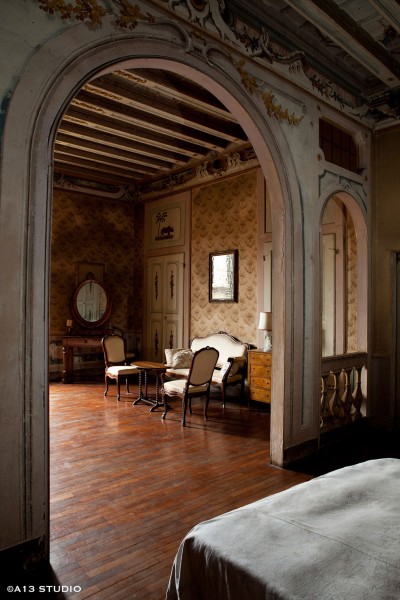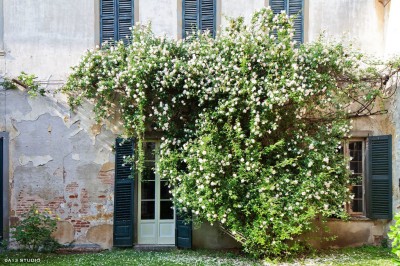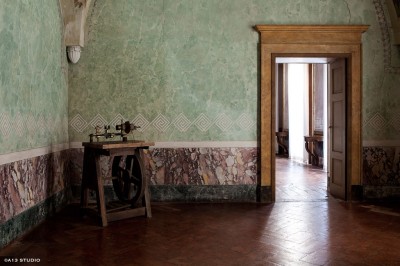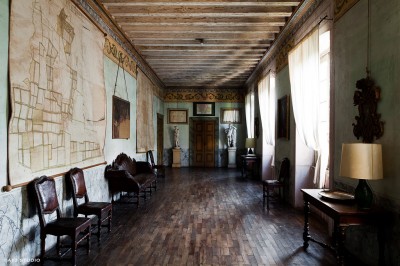Contact the abode
Today, the Castle of Secco Suardo is presented as an articulated set of buildings developed around the rectangular-shaped inner courtyard and other outbuildings that are directly connected to the main body of the Castle, encircling the entire structure. The west front, which runs parallel to Via Mazzini, contains the main door of one of the entrances overlooking the gardens and the Castle and facilitates access to the 16th-century noble family chapel. Several tombstones are preserved here, including that of the sarcophagus of Alberico Suardo. Dating from 1309, it is a rare example of equestrian high relief, attributed to one of the Campionesi Masters. There is also the plaque of the Ark of Baldino and Teutaldo. On the external front of the chapel, surmounting the entrance, is an interesting fresco of the Madonna with Saints, and a classical ‘Serliana’ that guarantees light entering the chapel.
The Garden
At the end of the eighteenth century the garden was transformed into a Botanical Garden by Gerolamo Secco Suardo, brother of the literary Paolina and a passionate lover of naturalistic disciplines. Even today the garden still preserves some rare and precious species of trees and plants. The main part of the building still retains an architectural structure dating back to the fifteenth century, characterised by the presence of a tower and a portico with cross vaults.
The Ground Floor
Remaining on the ground floor, directly across from the entrance are three rooms with fully decorated walls and cross vaults, one of which serves as a “dining room”. The remaining two chambers, named the "yellow room" and the "green room ", both of which are decorated in the neoclassical style, are used as living rooms. They lead to the light and joyous “Hall of the Bacchae” which looks out on one side to the garden and on the other to the inner courtyard. The walls have marble stucco with depictions of dancing maidens in the centre and anthropomorphic and floral decorations in the ceiling vaults. Adjoining the “Hall of the Bacchae” are the records office and the archive proper, where documents concerning the family’s history and information about the territory are stored.
The First Floor
Going up the main staircase, one arrives at a large gallery on the first floor which receives light from four large windows overlooking the garden, and doors leading to other rooms on the same floor. The first door gives access to a "Chinese inspired" drawing room, with 18th- and 19th-century decorations of panelled walls and an ornate slatted ceiling. This room then leads to various other interiors of historical significance, including the alcove, a precious example of 18th-century architecture with decorations that have been attributed to Galliari. The innermost section of the room is separated from the area facing the window by a structure that, in the manner of a theatrical backdrop, looks like the pediment of a three-arched loggia, containing two lower side arches that are enclosed by a gracious railing, just like a balcony. The area called the “north wing” contains another body of three stories, situated at a right angle with the portico, plus a mezzanine.
Other parts of the Castle
In addition to the large hall overlooking the garden, there is a vast 16th-century room on the ground floor, used as the Castle’s kitchen and containing a fireplace and a stove made out of stone. A stone spiral staircase leads to a mezzanine and then up to the first floor. This area, featuring an original and interesting layout possibly of Venetian influence, is characterised by a long, wide central reception room with a fireplace, that opens onto an outer loggia overlooking the garden on the North side. The entire building stands over a sprawling ramification of underground passages and tunnels (some of which are still closed and have not yet been explored) with vaulted ceilings and a series of air vents, perhaps indicative of a different quality of civilisation in ancient times.
The History of the Castle of Lurano
The history of the 'Castle' of Lurano is intertwined with that of the locality of the same name, located in the middle Bergamo plain, an area which possessed a wealth of water and was favourable for crops and cattle breeding. Archaeological finds attest to their being settlements living here since Roman times. In all likelihood, the first defensive structures in Lurano were built in the early Middle Ages, when it will have been a fortified enclosure within which the inhabitants of the houses scattered throughout the countryside took refuge in case of danger. The 'Castle', as it became known, was mentioned for the first time in a document dating from the year 1216. During the fourteenth and fifteenth centuries, the history of Lurano and its Castle were marked by conflicts between the dominant families and by the related violence and military clashes for domination. In February 1407, the Castle was besieged and subsequently set on fire by militia forces led by Jacopo dal Verme. From 1428, the territory of Bergamo was annexed to the Serenissima Republic of Venice. Lurano thus found itself in a strategic position on the border between the State of Milan and the Venetian Republic and became a defensive outpost.
The Secco Suardo family
In the 15th century, the Castle became the property of the Secco family, the overlords of Caravaggio at the time. In 1483, Socino II Secco appointed military architect Venturino Moroni to carry out some important commissions. In 1517, Socino II Secco, following the marriage of his daughter Maria to Ludovico Suardo, entrusted his nephew Marco Antonio Suardo with the entire property of Lurano, stipulating that the two surnames Secco and Suardo be united. The Castle thus became one of the primary residences of the Secco Suardo family, where they continued to live over generations, bequeathing historical, professional and personal testimonials. In the first part of the 17th century, the Castle was the scene for the battles between Galeazzo Secco Suardo and Bernardino Visconti; the latter inspired Alessandro Manzoni to create the character known as the “L’Innominato” or "The Unnamed One". In the eighteenth century, the first Botanical Garden in the province of Bergamo was created by Gerolamo Secco Suardo, featuring more than two thousand species of plants. In the 19th century, the Castle became the chief residence and workshop of Giovanni Secco Suardo, who was a leading historian figure in the period of the Italian restoration. Since 1991, Lurano Castle has been home to the Studies and Research Centre for the conservation and restoration of cultural heritage, named in honour of Giovanni Secco Suardo, and the National Historical Archive of Italian Restorers. To this day, it is the residence of the Secco Suardo family.
Services and Facilities at the Castle
Lurano Castle is the perfect location for receptions and functions: christenings, communions, confirmations and weddings, birthday parties for adults and children, graduation parties, corporate meetings and private events.
Conference Room, Concerts, Courses and Seminars
It is possible to reserve the Hall of the Bacchae for your conferences, concerts, courses and seminars. Catering may be arranged, and additional rooms are available for separate meeting places.
Photographic and Video Services
It is possible to hire out the entire property, which consists of several rooms on the ground floor and a number of rooms on the first and second floors.
Activities with schools
Lurano Castle collaborates with local schools; it is possible to book guided tours and educational workshops for primary school children. Duration: about 2 hours.
Music master classes and artists in residence
The Castle also has an independent suite and three rooms which can accommodate musicians staying with their teacher or artists looking for a retreat or a secluded place to work in peace.
Staying at the Castle
The property contains four fully independent apartments (three two-bedroomed and one four-bedroomed) that are available for medium- to long-term rentals. Guests can enjoy the unique experience of staying in an ancient castle just a stone's throw from Bergamo.
